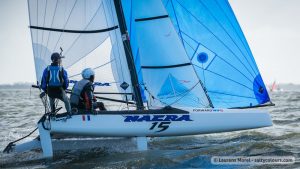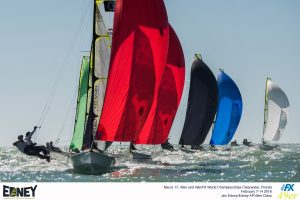
The History
The 29er was introduced in 1998 by designer Julian Bethwaite who also designed the 49er. The 29er was born due to the increased need for a suitable 49er youth trainer boat. It took about two years till the 29er was officially launched, in the article History of the 29er written by designer Julian Bethwaite, he writes, “We estimate that, including the five prototypes and the pre-production demonstration boats sailing in Australia, North America, and Europe, the 29er has now had over 5000 hours of testing – a figure that 
The Boat
The 29er is a two person, single trapeze, asymmetric spinnaker skiff boat. The boat is lightweight with a self-draining cockpit. The 29er has a fully battened mylar mainsail and self-tacking jib which allows the sailors to play the mainsheet upwind and makes gybing downwind easy for the sailors. Optimal crew weight is considered to be 270 to 320 pounds. Sailors around the world sail in mixed crews or all boy or all girl teams. The composite-tipped mast and spinnaker gives the 29er speed and acceleration downwind. With all its high-performance features the 29er is sure to give sailors a fun, fast, and exciting experience out on the water!
For More Information on the 29er class:
http://29ernorthamerican.org
https://www.29er.org
class profile
Nacra 15

The History
The production of the Nacra 15 began in 2015 and was designed from scratch to the ISAF criteria so it could become the official ISAF youth catamaran. The purpose was to replace the older catamarans and create a new catamaran that had a more modern design along with the ability to hold more crew weight. The Nacra 15 is a mini version of the Olympic Nacra 17, and thus creates a pathway towards the Olympics for youth sailors. The Nacra 15 plans on representing the future of cat sailing for youth around the world.
The Boat
The Nacra 15 is a semi-foiling catamaran which carries two curved daggerboards that provide lift. Less drag and more lift makes this boat faster and more exciting! The boat is 15.4 feet long and includes a mainsail, jib, and spinnaker. This official World Sailing youth multihull is exciting and fast but is safe for youth sailors. This boat is an excellent way for youth sailors to learn to work as a team. The Nacra 15 is one of the trainer boats in the Youth Olympic Development Program and serves as one of the pathways for youth sailors on a journey to the Olympics.
For More Information on the Nacra 15:
http://www.nacra15class.com
http://www.nacrasailing.com/project/nacra-15-pathway-for-youth-sailing/
One Design Class Profile: Nacra 15

The History
The production of the Nacra 15 began in 2015 and was designed from scratch to the ISAF criteria so it could become the official ISAF youth catamaran. The purpose was to replace the older catamarans and create a new catamaran that had a more modern design along with the ability to hold more crew weight. The Nacra 15 is a mini version of 
The Boat
The Nacra 15 is a semi-foiling catamaran which carries two curved daggerboards that provide lift. Less drag and more lift makes this boat faster and more exciting! The boat is 15.4 feet long and includes a mainsail, jib, and spinnaker. This official World Sailing youth multihull is exciting and fast but is safe for youth sailors. This boat is an excellent way for youth sailors to learn to work as a team. The Nacra 15 is one of the trainer boats in the Youth Olympic Development Program and serves as one of the pathways for youth sailors on a journey to the Olympics.
For More Information on the Nacra 15:
http://www.nacra15class.com
http://www.nacrasailing.com/project/nacra-15-pathway-for-youth-sailing/
One Design Class Profile: 49er
In 1996 the 49er was chosen to be the twin trapeze skiff choice for Olympic sailing. It was designed by Julian Bethwaite and is an evolution of the International 14’s and 
The History
The 49ers history starts back in 1996 where top sailors from around the world traveled to Lake Garda for a trial of different classes to see which would be the new twin-trapeze skiff for the 2000 Olympics in Sydney. The 49er proved to be the favorite for the sailors, and by November 1996 it was named the new Olympic skiff. Once named the Olympic skiff the production for the 49er was in high demand, with a waiting list developing within a matter of days after the Olympic announcement. Boat builders around the world worked hard to fill the demand. Two of the major boat builders that helped to grow 49er class are Ovington Boats based in England and Mackay Boats in New Zealand. The European Championships in Weymouth was the first international regatta held in September 1997. A total of 80 boats were already competing only a year after being announced as the new Olympic skiff. Since its launch in 1996, the 49er has been an instant hit and has evolved into the favorite skiff boat around the world.
The Boat
The name of the 49er comes from its hull length in meters, which is 4.99. Julian Bethwaite designed it, and it incorporates ideas from his design of the Aussie 18. The 49er is easy to handle and is controllable in conditions over 20 knots. Build out of fiberglass and carbon fiber the 49er is strong and light, weighing in at 275 pounds when fully rigged. As with any boat, the construction has gone through some changes through the years. In 2009 Mackay Boats build the new class molds which are now used by all builders worldwide. Also during this time, other improvements were made including a significant upgrade to the wings which are now pinned in place instead of sitting on sliding tracks. The wings are 9 feet wide with allows the crew to have maximum leverage. The sail area is 639 square feet which makes this small boat very fast! The vang uses a “ram vang” system; this system benefits the boat in three ways. First, it is a safer system because it pushes the boom down from above rather than pulling it down from below, which holds the mid-mast forward and prevents it from inverting when under pressure from the spinnaker. Second, it leaves the front cockpit open which allows for the crew to move more freely and efficiently across the boat. Thirdly, it brings the mainsail working area down to the deck level which helps reduce the drag. These boats are built for speed with top speeds over 20 knots, which makes it essential for the skipper and crew to work together to avoid any mistakes which can lead to capsizing. To be competitive on the water 49er sailors need to be reactive and quick-thinkers.
49erFX
The 49er introduced a new exciting form of sailing to the world. Mackay Boats in New Zealand found a way for more sailors to get involved and developed a smaller rig that fit into the 49er, the 49erFX. They trialed the 49erFX against several other boats, and it was selected to be used for the 2016 Olympics in Brazil. The 49erFX has made the experience of the 49er available to top women sailors. The FX uses a main with a wider head and only five battens, with the wider head a stiffer mast is needed to keep the boat in control through different wind conditions. The FX sail design makes it so that it can compete with the 49er in most upwind and downwind conditions. Two differences sailors notice the most between the 49er and FX is the rig depowers the boat, making it more easy to handle in winds 20-25 knots. Another positive difference is the performance downwind; the FX more easily bears away as the spinnaker is much flatter and flies further off the boat. Also, the bow lifts more out of the water which means sailors can go through waves without nosediving as they would in the 49er. This skiff requires sailors to be on top of their game with their skills, balance, and be in top shape. The 49erFX is a thrilling skiff that has paved the way for women sailors to compete in a high- performance boat and has shown the world that women sailors are amazing athletes!
For more info on the class go to www.49er.org
Click here for a video about the 49er.
Click here for a video about the 49erFX.
One Design Class Profile: J/70
Since the launch of the J/70 in 2012, the class has grown every year. Growing not only in the United States but around the world. Just this past September 161 boats participated in the J/70 World Championship held by Yacht Club Costa Smeralda in Sardinia, Italy. 
Brian Keane talks about the World event and the growth of the J/70 class, ”We chartered the J/70, so we are really pleased to have come second in the Championship. I have been racing in the Class since the beginning, and now that we have fleets racing J/70s all over the world, the standard is just amazing, and so is this regatta. A world record keelboat fleet in superb surroundings.”

The J/70 was designed to help to fill a need for a boat that is easy to own, easy to tow and launch, and easy to sail. This 22.75 foot boat is the first J/Boat that is a ramp
Features of the J/70:
- Easy to trailer
- Easy to launch
- Vertical lifting keel
- Comfortable cockpit
- Small cabin for storage
- Competitive edge, but easy to sail for kids to seniors.
Events Coming up in the USA:
2017-2018 Davis Island Winter Series – Tampa, FL – Dec 8-9th, Jan 19-21st, Feb 9-11th
2018 St Petersburg NOOD – St. Petersburg, FL – Feb 15-18th
2018 J/70 Midwinter Championship – Miami, FL – Feb 23-25th
2018 Bacardi Cup Invitational Regatta – Miami, FL – March 4-10th
2018 San Diego NOOD – San Diego, CA – March 16-18th
2018 Easter Regatta – Columbia, SC – March 29-April 1
2018 Charleston Race Week – Charleston, SC – April 12-15th
2018 J/70 Corinthian National Championship – Fort Worth, TX – April 26-29th
2018 World Championship – Marblehead, MA – Sep 22-29th
Learn More About The Class:
J/70 International Class Association
USA J/70 Class Association
J/Boats








